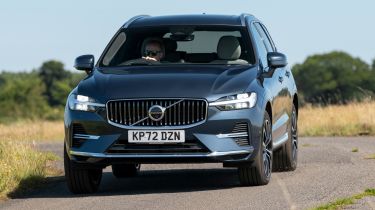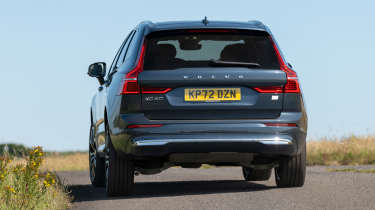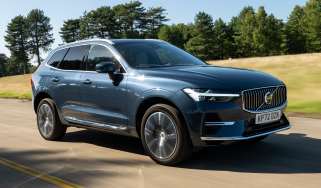Volvo XC60 review - Engines, drive & performance
It’s no rocket ship, but the Volvo XC60 should have plenty of punch for families
Volvo currently uses only 2.0-litre engines that are smaller in size than those fitted in some rivals, and while they aren’t class-leading in terms of performance, they’re likely to satisfy families and business users alike. With a good blend of economy and a reasonable turn of speed, most will find any XC60 a fine all-rounder, particularly seeing as it’s equipped with four-wheel drive and an automatic gearbox as standard. The engine lineup has been heavily reduced since the car launched, and now there’s just one petrol mild-hybrid and two plug-in hybrids on offer.
The XC60 suffers in direct comparisons with the Jaguar F-Pace and Porsche Macan – it can’t come close to providing a driving experience to compare with those two far sportier SUVs. It’s a closer match for the Audi Q5 and Lexus NX, with plenty of grip from its big, wide tyres, and just enough sensation through the steering wheel for it to still feel agile.
An adjustable suspension system fitted with the Ultra trim reduces the XC60’s ride height and has some effect on curbing the body lean that affects most versions when cornering hard. But even the adaptive air suspension of the Ultra model cannot inject much passion into the way the Volvo drives – it’s best viewed as a relaxed cruiser.
More reviews
Plus- and Ultra-spec cars also have larger wheels, which has a negative impact on the car's ability to glide over bumps. Although the Ultra model looks the part, we reckon the Core and Plus models are better all-rounders. You’re far better off leaving the suspension in comfort mode and enjoying the effortless way bumps and motorway imperfections are dealt with.
Petrol engines
The B5 model comes with a 2.0-litre turbocharged petrol engine producing 247bhp and four-wheel drive, which is enough to get the XC60 from 0-62mph in 6.9 seconds. The appeal of the B5 though, lies in its quiet, relaxing nature, particularly at low speeds.
The now-discontinued petrol B6 was powered by the same turbocharged 2.0-litre engine but with an increased power output of 296bhp. It offers 0-62mph in 6.2 seconds but this isn’t an engine that responds particularly well to enthusiastic driving. The automatic gearbox doesn’t like to be hurried, either – you don’t get the instant changes of a Porsche Macan or Jaguar F-Pace.
Hybrid engines
Introduced for 2020, the T6 is the entry-level XC60 plug-in hybrid. Its 2.0-litre petrol engine and electric motor combine to produce 345bhp, giving it the ability to sprint from 0-62mph in 5.7 seconds. When using battery power, it promises silent electric running for a distance of up to 50 miles.
The car is at its smoothest and most refined when running in electric-only ‘Pure’ mode, with almost no sound at all from its electric motor. It’s also pretty keen to accelerate off the line, because the motor has clearly been tuned to give its all early on in the pedal travel – push harder and there’s only a modest increase in acceleration, but you can get up to A-road speeds without fuss. In ‘Hybrid’ mode, things can be a bit more jerky as the electric motor and petrol engine juggle power, but once both are giving their all, acceleration is quite impressive.
Volvo XC60 diesel engines
As of 2024 all the diesels have been discontinued, likely due to general falling demand in the diesel market, so your only option for diesel models is to go for a used model. The B4 diesel with mild-hybrid tech had 195bhp and managed 0-62mph in 8.3 seconds in four-wheel-drive form.
The most powerful diesel was the 232bhp B5, which offers considerably more pace with four-wheel drive as standard for used XC60 buyers. This version reaches 62mph from rest in just over seven seconds, matching the Jaguar F-Pace, and features innovative technology that uses a whoosh of compressed air to get the turbo working faster when you press the accelerator.
Volvo previously offered a manual gearbox in the diesel XC60, but the eight-speed automatic suits the nature of the car better and now comes as standard across all models. For the most part, it offers smooth changes – especially as you gradually accelerate. It’s not the quickest to respond to a sudden press of the throttle though, or to downshifts if you manually nudge the gearlever, and sometimes it can hang in gears as you slow to a stop, requiring a firm shove of the brake pedal as you come to a halt.














